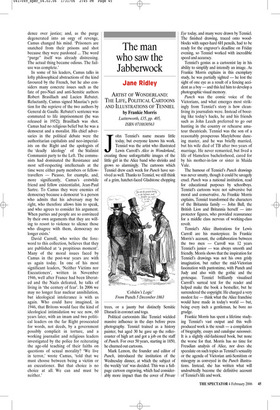The man who saw the Jabberwock
Jane Ridley
ARTIST OF WONDERLAND: THE LIFE, POLITICAL CARTOONS AND ILLUSTRATIONS OF TENNIEL by Frankie Morris Luttterworth, £35, pp. 405, ISBN 0718830563 John Tenniel’s name means little today, but everyone knows his work. Tenniel was the artist who illustrated Lewis Carroll’s Alice in Wonderland, creating those unforgettable images of the little girl in the Alice band who shrinks and grows so alarmingly. The cartoons which Tenniel drew each week for Punch have survived as well. Thanks to Tenniel, we still think of a grim, hatchet-faced Gladstone chopping trees, or a jaunty but distinctly Semitic Disraeli in coronet and toga.
Political cartoonists like Tenniel wielded massive influence in the days before press photography. Tenniel trained as a history painter, but aged 30 he gave up the rollercoaster of high art and got a job on the staff of Punch. For over 50 years, starting in 1850, he churned out cartoons.
Mark Lemon, the founder and editor of Punch, introduced the institution of the Wednesday dinner, at which the subject of the weekly ‘cut’ was decided. This was a fullpage cartoon engraving, which had considerably more impact than the cover of Private Eye today, and many were drawn by Tenniel. The finished drawing, traced onto woodblocks with super-hard 6H pencils, had to be ready for the engraver’s deadline on Friday evening, so Tenniel worked with incredible speed and accuracy.
Tenniel’s genius as a cartoonist lay in his ability to simplify and intensify an image. As Frankie Morris explains in this exemplary study, he was partially sighted — he lost the sight of one eye as a result of a fencing accident as a boy — and this led him to develop a photographic visual memory.
Punch was the comic voice of the Victorians, and what emerges most strikingly from Tenniel’s story is how cleanliving its journalists were. Instead of boozing like today’s hacks, he and his friends such as John Leech preferred to go out hunting in the country or rehearse amateur theatricals. Tenniel was the son of a reasonably prosperous Marylebone dancing master, and he was briefly married, but his wife died of TB after two years of marriage. He never remarried, but lived a life of blameless bachelorhood, cared for by his mother-in-law or sister in Maida Vale.
The humour of Tenniel’s Punch drawings was never smutty, though it could be savagely cruel. Punch was a national institution, read for educational purposes by schoolboys. Tenniel’s cartoons were not subversive but moral and conservative. As Frankie Morris explains, Tenniel transformed the characters of the Britannia family — John Bull, the British Lion and Britannia herself — into protector figures, who provided reassurance for a middle class nervous of working-class revolt.
Tenniel’s Alice illustrations for Lewis Carroll are his masterpiece. In Frankie Morris’s account, the collaboration between the two men — Carroll was 12 years Tenniel’s junior — was always smooth and friendly. Morris shows that the inspiration for Tenniel’s drawings was not his own grisly imagination, but rather the mid-Victorian fascination with pantomime, with Punch and Judy and also with the gothic and the grotesque. Tenniel brilliantly visualised Carroll’s surreal text for the reader and helped make the book a bestseller, but he surrendered the copyright. He charged a very modest fee — think what the Alice franchise would have made in today’s world — but, being every inch a gentleman, he bore no grudge.
Frankie Morris has spent a lifetime studying Tenniel’s vast output and this wellproduced work is the result — a compilation of biography, essays and catalogue raisonnée. It is a slightly old-fashioned book, but none the worse for that. Morris has no time for Freudian analysis of Alice, nor does she speculate on such topics as Tenniel’s sexuality or the agenda of Victorian anti-Semitism or misogyny as conveyed in the Punch illustrations. Instead, she has written what will undoubtedly become the definitive account of Tenniel’s life and work.





























































































































 Previous page
Previous page